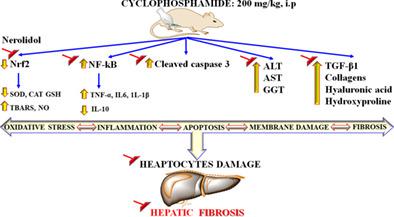当前位置:
X-MOL 学术
›
Biofactors
›
论文详情
Our official English website, www.x-mol.net, welcomes your feedback! (Note: you will need to create a separate account there.)
Nerolidol protects the liver against cyclophosphamide-induced hepatic inflammation, apoptosis, and fibrosis via modulation of Nrf2, NF-κB p65, and caspase-3 signaling molecules in Swiss albino mice.
Biofactors ( IF 6 ) Pub Date : 2020-09-17 , DOI: 10.1002/biof.1679 Ashif Iqubal 1 , Mansoor Ali Syed 2 , Javed Ali 3 , Abul Kalam Najmi 1 , Mohammad Mahfuzul Haque 2 , Syed Ehtaishamul Haque 1
Biofactors ( IF 6 ) Pub Date : 2020-09-17 , DOI: 10.1002/biof.1679 Ashif Iqubal 1 , Mansoor Ali Syed 2 , Javed Ali 3 , Abul Kalam Najmi 1 , Mohammad Mahfuzul Haque 2 , Syed Ehtaishamul Haque 1
Affiliation

|
Cyclophosphamide (CP)‐induced hepatotoxic manifestations are major concern for patients undergoing chemotherapy, which often limit its therapeutic utility. Nerolidol (NER) is a natural bioactive molecule having potent gonadoprotective, neuroprotective, and cardioprotective properties but has not been explored for its hepatoprotective effect and underlying mechanism. Therefore, in the current study hepatoprotective potential of nerolidol was studied in CP‐induced hepatic oxidative stress, inflammation, apoptosis, and fibrosis via modulation of Nrf2, NF‐κB p65, caspase‐3, TGF‐β1, and associated biochemical status in Swiss albino mice. NER (200, 400 mg/kg, p.o) and fenofibrate (FF) 80 mg/kg, p.o. were administered from first to fourteenth day and CP was administered at the dose of 200 mg/kg, i.p on seventh day. On fifteenth day, animals were sacrificed and estimation of oxidative stress, inflammation, apoptosis, fibrosis, histopathology (H E and MT staining), and immunohistochemistry was performed in the liver tissue. Administration of NER effectively normalized the elevated level of hepatic injury markers (alanine aminotransferase, aspartate aminotransferase, and alkaline phosphatase), marker of oxidative stress that is, malondialdehyde, inflammatory cytokines (TNF‐α, IL‐6, IL‐1β, and IL‐10), NF‐κB p65, apoptotic marker (cleaved caspase 3) and increased the level of Nrf2 and antioxidant enzymes (superoxide dismutase, CAT, and glutathione). Treatment with NER further reduced the structural damage of hepatocytes and markers of hepatic fibrosis such as TGF‐β1, hyaluronic acid, 4‐hydroxyproline and collagen‐rich stained area, estimated by MT staining. Findings of the current study showed that nerolidol exhibited potent antioxidant, anti‐inflammatory, anti‐apoptotic, and anti‐fibrotic potential and thus acted as hepatoprotective agent. Present study represents novel mechanism of nerolidol against CP‐induced hepatotoxicity. However, further studies are needed to use nerolidol as an adjuvant in chemotherapeutically treated patients.
中文翻译:

橙花醇通过调节瑞士白化小鼠的 Nrf2、NF-κB p65 和 caspase-3 信号分子,保护肝脏免受环磷酰胺诱导的肝脏炎症、细胞凋亡和纤维化。
环磷酰胺 (CP) 诱导的肝毒性表现是接受化疗的患者的主要关注点,这通常限制了其治疗效用。橙花醇 (NER) 是一种天然生物活性分子,具有强大的性腺保护、神经保护和心脏保护特性,但尚未对其保肝作用和潜在机制进行探索。因此,在目前的研究中,通过调节 Nrf2、NF-κB p65、caspase-3、TGF-β1 和相关的生化状态,研究了橙花醇在 CP 诱导的肝脏氧化应激、炎症、细胞凋亡和纤维化中的保肝潜力。白化小鼠。NER (200, 400 mg/kg, po) 和非诺贝特 (FF) 80 mg/kg, po 从第一天到第十四天给药,CP 以 200 mg/kg 的剂量在第七天 ip 给药。第十五天,处死动物,并在肝组织中进行氧化应激、炎症、细胞凋亡、纤维化、组织病理学(HE 和 MT 染色)和免疫组织化学的评估。NER 的给药有效地使升高的肝损伤标志物(丙氨酸氨基转移酶、天冬氨酸氨基转移酶和碱性磷酸酶)、氧化应激标志物即丙二醛、炎症细胞因子(TNF-α、IL-6、IL-1β 和 IL ‐10)、NF-κB p65、凋亡标记物(裂解的半胱天冬酶 3)并增加 Nrf2 和抗氧化酶(超氧化物歧化酶、CAT 和谷胱甘肽)的水平。通过 MT 染色估计,NER 治疗进一步减少了肝细胞的结构损伤和肝纤维化标志物,如 TGF-β1、透明质酸、4-羟脯氨酸和富含胶原蛋白的染色区域。目前的研究结果表明,橙花醇具有强大的抗氧化、抗炎、抗细胞凋亡和抗纤维化潜力,因此可作为保肝剂。目前的研究代表了橙花醇对抗 CP 诱导的肝毒性的新机制。然而,需要进一步研究将橙花醇用作接受化疗的患者的佐剂。
更新日期:2020-09-17
中文翻译:

橙花醇通过调节瑞士白化小鼠的 Nrf2、NF-κB p65 和 caspase-3 信号分子,保护肝脏免受环磷酰胺诱导的肝脏炎症、细胞凋亡和纤维化。
环磷酰胺 (CP) 诱导的肝毒性表现是接受化疗的患者的主要关注点,这通常限制了其治疗效用。橙花醇 (NER) 是一种天然生物活性分子,具有强大的性腺保护、神经保护和心脏保护特性,但尚未对其保肝作用和潜在机制进行探索。因此,在目前的研究中,通过调节 Nrf2、NF-κB p65、caspase-3、TGF-β1 和相关的生化状态,研究了橙花醇在 CP 诱导的肝脏氧化应激、炎症、细胞凋亡和纤维化中的保肝潜力。白化小鼠。NER (200, 400 mg/kg, po) 和非诺贝特 (FF) 80 mg/kg, po 从第一天到第十四天给药,CP 以 200 mg/kg 的剂量在第七天 ip 给药。第十五天,处死动物,并在肝组织中进行氧化应激、炎症、细胞凋亡、纤维化、组织病理学(HE 和 MT 染色)和免疫组织化学的评估。NER 的给药有效地使升高的肝损伤标志物(丙氨酸氨基转移酶、天冬氨酸氨基转移酶和碱性磷酸酶)、氧化应激标志物即丙二醛、炎症细胞因子(TNF-α、IL-6、IL-1β 和 IL ‐10)、NF-κB p65、凋亡标记物(裂解的半胱天冬酶 3)并增加 Nrf2 和抗氧化酶(超氧化物歧化酶、CAT 和谷胱甘肽)的水平。通过 MT 染色估计,NER 治疗进一步减少了肝细胞的结构损伤和肝纤维化标志物,如 TGF-β1、透明质酸、4-羟脯氨酸和富含胶原蛋白的染色区域。目前的研究结果表明,橙花醇具有强大的抗氧化、抗炎、抗细胞凋亡和抗纤维化潜力,因此可作为保肝剂。目前的研究代表了橙花醇对抗 CP 诱导的肝毒性的新机制。然而,需要进一步研究将橙花醇用作接受化疗的患者的佐剂。


























 京公网安备 11010802027423号
京公网安备 11010802027423号